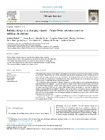Building design in a changing climate – Future Swiss reference years for building simulations
dc.contributor.author
Wehrli, Kathrin
dc.contributor.author
Sidler, Franz
dc.contributor.author
Gubler, Stefanie
dc.contributor.author
Settembrini, Gianrico
dc.contributor.author
Koschenz, Markus
dc.contributor.author
Domingo Irigoyen, Silvia
dc.contributor.author
Kotlarski, Sven
dc.contributor.author
Fischer, Andreas M.
dc.contributor.author
Zweifel, Gerhard
dc.date.accessioned
2024-02-28T11:42:53Z
dc.date.available
2024-02-28T09:49:13Z
dc.date.available
2024-02-28T11:42:53Z
dc.date.issued
2024-04
dc.identifier.issn
2405-8807
dc.identifier.other
10.1016/j.cliser.2024.100448
en_US
dc.identifier.uri
http://hdl.handle.net/20.500.11850/661991
dc.identifier.doi
10.3929/ethz-b-000661991
dc.description.abstract
With global climate change, temperatures in Switzerland are projected to rise in the coming decades, according to the national climate scenarios CH2018. Associated with the mean temperature increase, heatwaves are expected to become longer, more frequent, and more intense. The changing climate will affect the indoor climate as well as heating and cooling needs. In building design, these climatic changes have to be planned for today in order to ensure a comfortable indoor climate in the future. In collaboration with practitioners, a reference climate data set for the future is created that specifically targets building designers and engineers. The data set consists of hourly weather data of one-year length based on the Swiss climate change scenarios CH2018. These future reference years are representative of two time periods in the future: one around 2030 and one around 2060. Climate change uncertainty is considered by using two emission scenarios (RCP2.6 and RCP8.5). Reference data for the future is provided not only for a typical year (called Design Reference Year, or DRY) but also for an above-average warm summer. The data is available at the sites of 45 measurement stations across Switzerland, including four stations inside major cities to take the urban heat island effect into account. The generated climate data set is applied to a building model to provide an application example. The results point out that the cooling needs will substantially increase, which is why an adaptation of the building design to the changing climate is vital.
en_US
dc.format
application/pdf
en_US
dc.language.iso
en
en_US
dc.publisher
Elsevier
en_US
dc.rights.uri
http://creativecommons.org/licenses/by/4.0/
dc.subject
Indoor temperature
en_US
dc.subject
Building design
en_US
dc.subject
Climate scenario
en_US
dc.subject
Urban climate
en_US
dc.subject
Design reference year
en_US
dc.title
Building design in a changing climate – Future Swiss reference years for building simulations
en_US
dc.type
Journal Article
dc.rights.license
Creative Commons Attribution 4.0 International
dc.date.published
2024-02-16
ethz.journal.title
Climate Services
ethz.journal.volume
34
en_US
ethz.pages.start
100448
en_US
ethz.size
14 p.
en_US
ethz.version.deposit
publishedVersion
en_US
ethz.identifier.wos
ethz.identifier.scopus
ethz.publication.status
published
en_US
ethz.date.deposited
2024-02-28T09:49:14Z
ethz.source
SCOPUS
ethz.eth
yes
en_US
ethz.availability
Open access
en_US
ethz.rosetta.installDate
2024-02-28T11:42:55Z
ethz.rosetta.lastUpdated
2024-02-28T11:42:55Z
ethz.rosetta.exportRequired
true
ethz.rosetta.versionExported
true
ethz.COinS
ctx_ver=Z39.88-2004&rft_val_fmt=info:ofi/fmt:kev:mtx:journal&rft.atitle=Building%20design%20in%20a%20changing%20climate%20%E2%80%93%20Future%20Swiss%20reference%20years%20for%20building%20simulations&rft.jtitle=Climate%20Services&rft.date=2024-04&rft.volume=34&rft.spage=100448&rft.issn=2405-8807&rft.au=Wehrli,%20Kathrin&Sidler,%20Franz&Gubler,%20Stefanie&Settembrini,%20Gianrico&Koschenz,%20Markus&rft.genre=article&rft_id=info:doi/10.1016/j.cliser.2024.100448&
Files in this item
Publication type
-
Journal Article [128920]

